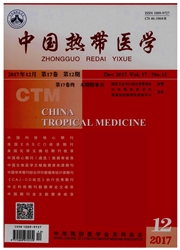

 中文摘要:
中文摘要:
目的了解云南省西双版纳州2016年登革热流行特征和登革病毒血清型、基因型及其传播来源。方法收集登革热病例资料,采集患者急性期血清标本,用RT-PCR法检测登革病毒核酸,并进行登革病毒C/Pr M区核苷酸序列测定和进化分析。结果 2016年西双版纳州共确诊登革热病例53例,其中本地感染病例24例(勐腊县21例和景洪市3例),输入性病例29例(来自缅甸24例和老挝5例)。流行月份为7—11月。病例年龄以20~49岁组为主,男女性别比为1.9∶1。蚊媒监测景洪5—10月布雷图指数(Breteau index,BI)为8.4~21,勐腊6—10月BI为7.6~18.2,勐海县9—10月BI为8.4~8.8,其它月份BI均小于5。从患者血清中获得13株登革病毒的C/Pr M区基因核苷酸序列,进化分析表明,10株为登革病毒血清型1型(DENV-1)中的基因I型(Genotype-I,G-I),3株为登革病毒血清型2型(DENV-2)的亚洲基因I型(Asian genotype I,AG-I),均为东南亚地区的优势基因型。无论DENV-1或DENV-2均与近几年云南省瑞丽市、临沧市和东南亚地区的同型流行株具有较近的亲缘关系。结论西双版纳州2016年发生了包括本地和输入性病例并存的DENV-1 G-I和DENV-2 AG-I流行,并证实相邻的缅甸和老挝边境地区存在这两种血清型登革病毒流行,来自缅甸和老挝的输入性病例是引起西双版纳本地流行的主要原因。此为西双版纳首次发生DENV-1和DENV-2 AG-I的本地流行。
 英文摘要:
英文摘要:
Objective To understand the epidemiologic features of an epidemic of dengue fever(DF) in XishuangbannaPrefecture of Yunnan Province, China, 2016 with its viral serotype, genotype and transmission source. Methods The data ofDF cases in Xishuangbanna were collected. The serum samples from these patients(in acute stage) were collected to detect theviral nucleic acid by RT-PCR assay. The phylogenetic tree was analyzed and generated based on the nucleotide sequence of C/Pr M gene fragments of dengue virus(DENV). Results A total of 53 cases of DF were reported in the prefecture in 2016. Ofthem, 24 were indigenous cases, i.e., 21 from Mengla County and 3 from Jinghong County; 29 were imported cases, i.e. 24 fromMyanmar and 5 from Laos. The epidemic months of DF were from July to November. The majority of patients were aged from 20 to 49 years. The male to female ratio was 1.9∶1. The Breteau indexes(BI) of Aedes mosquito surveillance were 8.4-21 from Mayto October in Jinghong, 7.6-18.2 from June to October in Mengla, 8.4-8.8 from September to October in Menghai and below 5in other months in the above areas. The results of virus nucleic acid detection and sequencing indicated that nucleotidesequences of C/Pr M of 13 virus strains were obtained from the DF cases. Phylogenetic analysis indicated that 10 virus strainsbelonged to genotype I(G-I) of DENV serotype 1(DENV-1), and three virus strains belonged to Asian genotype I(AG-I) ofDENV serotype 2(DENV-2). The two genotypes were mainly predominant in Southeastern Asia. All the 13 DENV strains fromXishuangbanna had a closer genetic relationship with the DENV strains from Ruili City and Lincang Prefecture of YunnanProvince, and countries in Southeast Asia in recent years. Conclusions The epidemic of DENV-1 G-I and DENV-2 AG-Iis confirmed in Xishuangbanna in 2016 and both indigenous and imported cases are detected. The evidence also shows thatboth DENV-1 and DENV-2 epidemic strains do exist in the border region of Myanmar and Lao in 2016. The i
 同期刊论文项目
同期刊论文项目
 同项目期刊论文
同项目期刊论文
 期刊信息
期刊信息
